NISSAN ROGUE 2021 Owner´s Manual
Manufacturer: NISSAN, Model Year: 2021, Model line: ROGUE, Model: NISSAN ROGUE 2021Pages: 556, PDF Size: 2.7 MB
Page 41 of 556
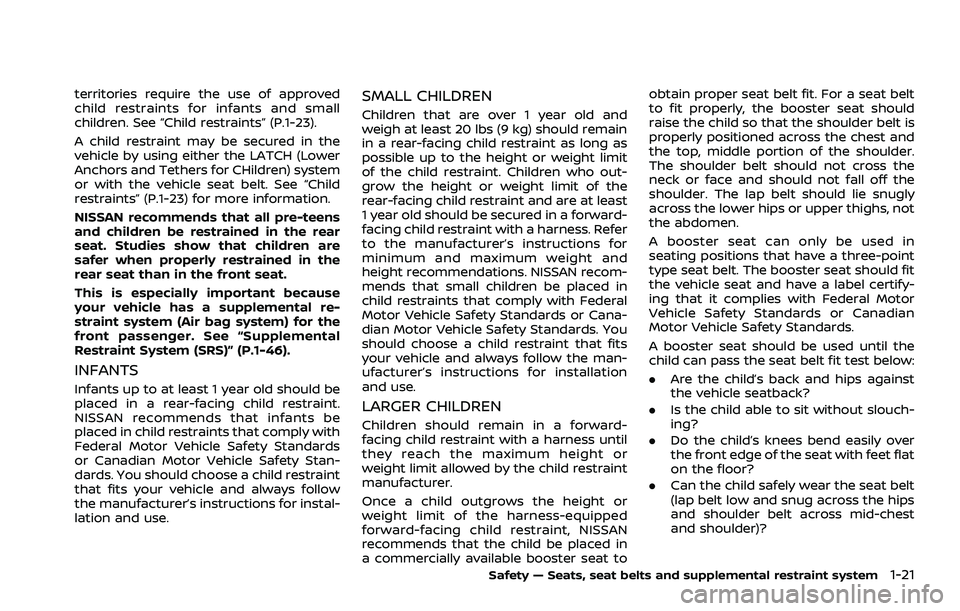
territories require the use of approved
child restraints for infants and small
children. See “Child restraints” (P.1-23).
A child restraint may be secured in the
vehicle by using either the LATCH (Lower
Anchors and Tethers for CHildren) system
or with the vehicle seat belt. See “Child
restraints” (P.1-23) for more information.
NISSAN recommends that all pre-teens
and children be restrained in the rear
seat. Studies show that children are
safer when properly restrained in the
rear seat than in the front seat.
This is especially important because
your vehicle has a supplemental re-
straint system (Air bag system) for the
front passenger. See “Supplemental
Restraint System (SRS)” (P.1-46).
INFANTS
Infants up to at least 1 year old should be
placed in a rear-facing child restraint.
NISSAN recommends that infants be
placed in child restraints that comply with
Federal Motor Vehicle Safety Standards
or Canadian Motor Vehicle Safety Stan-
dards. You should choose a child restraint
that fits your vehicle and always follow
the manufacturer’s instructions for instal-
lation and use.
SMALL CHILDREN
Children that are over 1 year old and
weigh at least 20 lbs (9 kg) should remain
in a rear-facing child restraint as long as
possible up to the height or weight limit
of the child restraint. Children who out-
grow the height or weight limit of the
rear-facing child restraint and are at least
1 year old should be secured in a forward-
facing child restraint with a harness. Refer
to the manufacturer’s instructions for
minimum and maximum weight and
height recommendations. NISSAN recom-
mends that small children be placed in
child restraints that comply with Federal
Motor Vehicle Safety Standards or Cana-
dian Motor Vehicle Safety Standards. You
should choose a child restraint that fits
your vehicle and always follow the man-
ufacturer’s instructions for installation
and use.
LARGER CHILDREN
Children should remain in a forward-
facing child restraint with a harness until
they reach the maximum height or
weight limit allowed by the child restraint
manufacturer.
Once a child outgrows the height or
weight limit of the harness-equipped
forward-facing child restraint, NISSAN
recommends that the child be placed in
a commercially available booster seat toobtain proper seat belt fit. For a seat belt
to fit properly, the booster seat should
raise the child so that the shoulder belt is
properly positioned across the chest and
the top, middle portion of the shoulder.
The shoulder belt should not cross the
neck or face and should not fall off the
shoulder. The lap belt should lie snugly
across the lower hips or upper thighs, not
the abdomen.
A booster seat can only be used in
seating positions that have a three-point
type seat belt. The booster seat should fit
the vehicle seat and have a label certify-
ing that it complies with Federal Motor
Vehicle Safety Standards or Canadian
Motor Vehicle Safety Standards.
A booster seat should be used until the
child can pass the seat belt fit test below:
.
Are the child’s back and hips against
the vehicle seatback?
. Is the child able to sit without slouch-
ing?
. Do the child’s knees bend easily over
the front edge of the seat with feet flat
on the floor?
. Can the child safely wear the seat belt
(lap belt low and snug across the hips
and shoulder belt across mid-chest
and shoulder)?
Safety — Seats, seat belts and supplemental restraint system1-21
Page 42 of 556
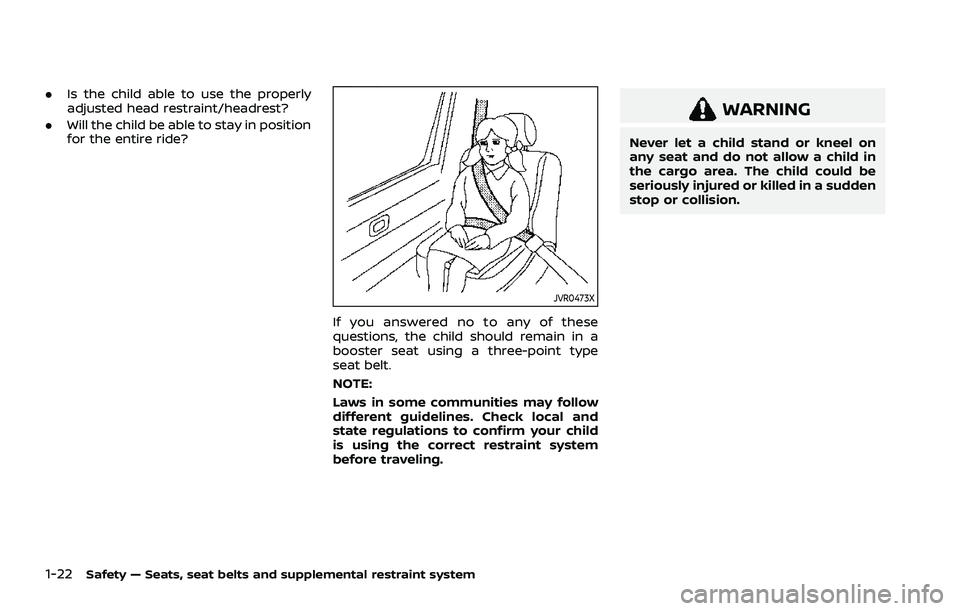
1-22Safety — Seats, seat belts and supplemental restraint system
.Is the child able to use the properly
adjusted head restraint/headrest?
. Will the child be able to stay in position
for the entire ride?
JVR0473X
If you answered no to any of these
questions, the child should remain in a
booster seat using a three-point type
seat belt.
NOTE:
Laws in some communities may follow
different guidelines. Check local and
state regulations to confirm your child
is using the correct restraint system
before traveling.
WARNING
Never let a child stand or kneel on
any seat and do not allow a child in
the cargo area. The child could be
seriously injured or killed in a sudden
stop or collision.
Page 43 of 556
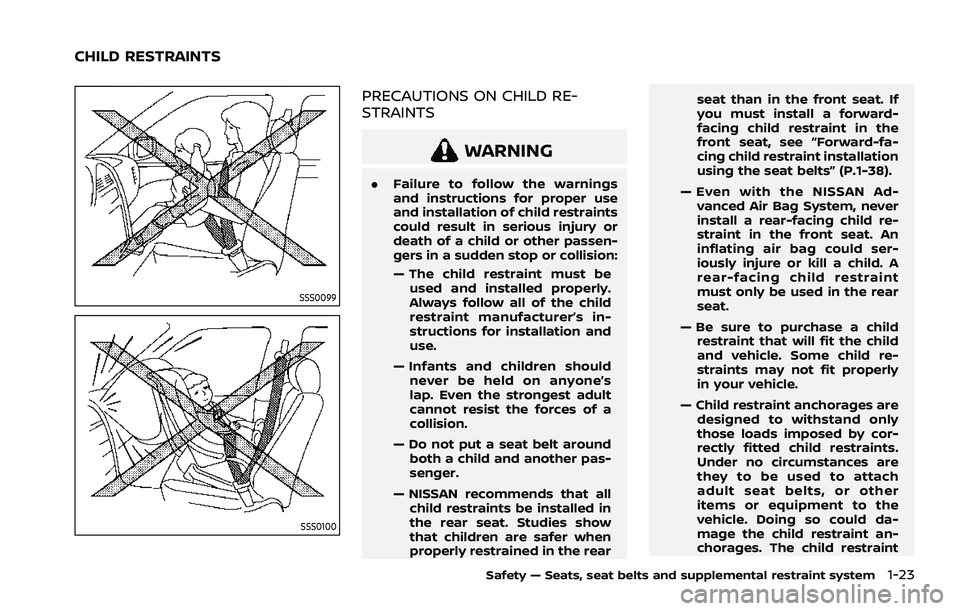
SSS0099
SSS0100
PRECAUTIONS ON CHILD RE-
STRAINTS
WARNING
.Failure to follow the warnings
and instructions for proper use
and installation of child restraints
could result in serious injury or
death of a child or other passen-
gers in a sudden stop or collision:
— The child restraint must be
used and installed properly.
Always follow all of the child
restraint manufacturer’s in-
structions for installation and
use.
— Infants and children should never be held on anyone’s
lap. Even the strongest adult
cannot resist the forces of a
collision.
— Do not put a seat belt around both a child and another pas-
senger.
— NISSAN recommends that all child restraints be installed in
the rear seat. Studies show
that children are safer when
properly restrained in the rear seat than in the front seat. If
you must install a forward-
facing child restraint in the
front seat, see “Forward-fa-
cing child restraint installation
using the seat belts” (P.1-38).
— Even with the NISSAN Ad- vanced Air Bag System, never
install a rear-facing child re-
straint in the front seat. An
inflating air bag could ser-
iously injure or kill a child. A
rear-facing child restraint
must only be used in the rear
seat.
— Be sure to purchase a child restraint that will fit the child
and vehicle. Some child re-
straints may not fit properly
in your vehicle.
— Child restraint anchorages are designed to withstand only
those loads imposed by cor-
rectly fitted child restraints.
Under no circumstances are
they to be used to attach
adult seat belts, or other
items or equipment to the
vehicle. Doing so could da-
mage the child restraint an-
chorages. The child restraint
Safety — Seats, seat belts and supplemental restraint system1-23
CHILD RESTRAINTS
Page 44 of 556
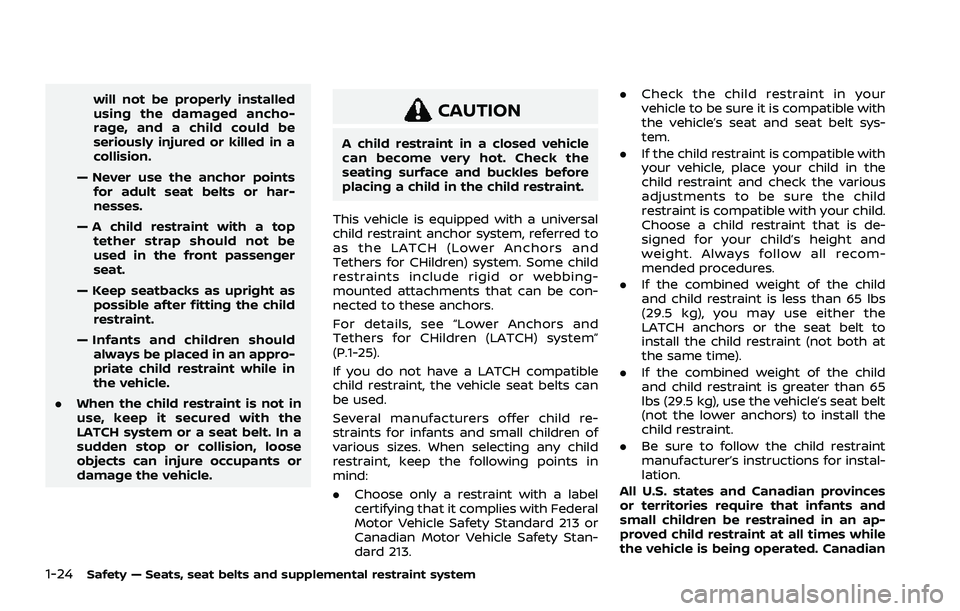
1-24Safety — Seats, seat belts and supplemental restraint system
will not be properly installed
using the damaged ancho-
rage, and a child could be
seriously injured or killed in a
collision.
— Never use the anchor points for adult seat belts or har-
nesses.
— A child restraint with a top tether strap should not be
used in the front passenger
seat.
— Keep seatbacks as upright as possible after fitting the child
restraint.
— Infants and children should always be placed in an appro-
priate child restraint while in
the vehicle.
. When the child restraint is not in
use, keep it secured with the
LATCH system or a seat belt. In a
sudden stop or collision, loose
objects can injure occupants or
damage the vehicle.CAUTION
A child restraint in a closed vehicle
can become very hot. Check the
seating surface and buckles before
placing a child in the child restraint.
This vehicle is equipped with a universal
child restraint anchor system, referred to
as the LATCH (Lower Anchors and
Tethers for CHildren) system. Some child
restraints include rigid or webbing-
mounted attachments that can be con-
nected to these anchors.
For details, see “Lower Anchors and
Tethers for CHildren (LATCH) system”
(P.1-25).
If you do not have a LATCH compatible
child restraint, the vehicle seat belts can
be used.
Several manufacturers offer child re-
straints for infants and small children of
various sizes. When selecting any child
restraint, keep the following points in
mind:
. Choose only a restraint with a label
certifying that it complies with Federal
Motor Vehicle Safety Standard 213 or
Canadian Motor Vehicle Safety Stan-
dard 213. .
Check the child restraint in your
vehicle to be sure it is compatible with
the vehicle’s seat and seat belt sys-
tem.
. If the child restraint is compatible with
your vehicle, place your child in the
child restraint and check the various
adjustments to be sure the child
restraint is compatible with your child.
Choose a child restraint that is de-
signed for your child’s height and
weight. Always follow all recom-
mended procedures.
. If the combined weight of the child
and child restraint is less than 65 lbs
(29.5 kg), you may use either the
LATCH anchors or the seat belt to
install the child restraint (not both at
the same time).
. If the combined weight of the child
and child restraint is greater than 65
lbs (29.5 kg), use the vehicle’s seat belt
(not the lower anchors) to install the
child restraint.
. Be sure to follow the child restraint
manufacturer’s instructions for instal-
lation.
All U.S. states and Canadian provinces
or territories require that infants and
small children be restrained in an ap-
proved child restraint at all times while
the vehicle is being operated. Canadian
Page 45 of 556

law requires the top tether strap on
forward-facing child restraints be se-
cured to the designated anchor point
on the vehicle.
WAB0108XLATCH system anchor location
Lower Anchors and Tethers for
CHildren (LATCH) SYSTEM
Your vehicle is equipped with special
anchor points that are used with LATCH
system compatible child restraints. This
system may also be referred to as the
ISOFIX or ISOFIX compatible system. With
this system, you do not have to use a
vehicle seat belt to secure the child
restraint unless the combined weight of
the child and child restraint exceeds 65
lbs (29.5 kg). If the combined weight of the
child and child restraint is greater than 65
lbs (29.5 kg), use the vehicle’s seat belt
(not the lower anchors) to install the child
restraint. Be sure to follow the childrestraint manufacturer’s instructions for
installation.
The LATCH anchor points can be used to
install child restraints in either of the rear
outboard seating positions or in the
center rear seating position. Please refer
to the following section of this Owner’s
Manual for specific information about
installing a child restraint in the center
rear seating position using the LATCH
anchors.
CAUTION
Store the loose LATCH covers (for
example, in the console box) where
they will not get damaged to avoid
losing them. (See “Console box” (P.2-
75).)
LATCH lower anchor
WARNING
Failure to follow the warnings and
instructions for proper use and in-
stallation of child restraints could
result in serious injury or death of a
child or other passengers in a sud-
den stop or collision:
Safety — Seats, seat belts and supplemental restraint system1-25
Page 46 of 556
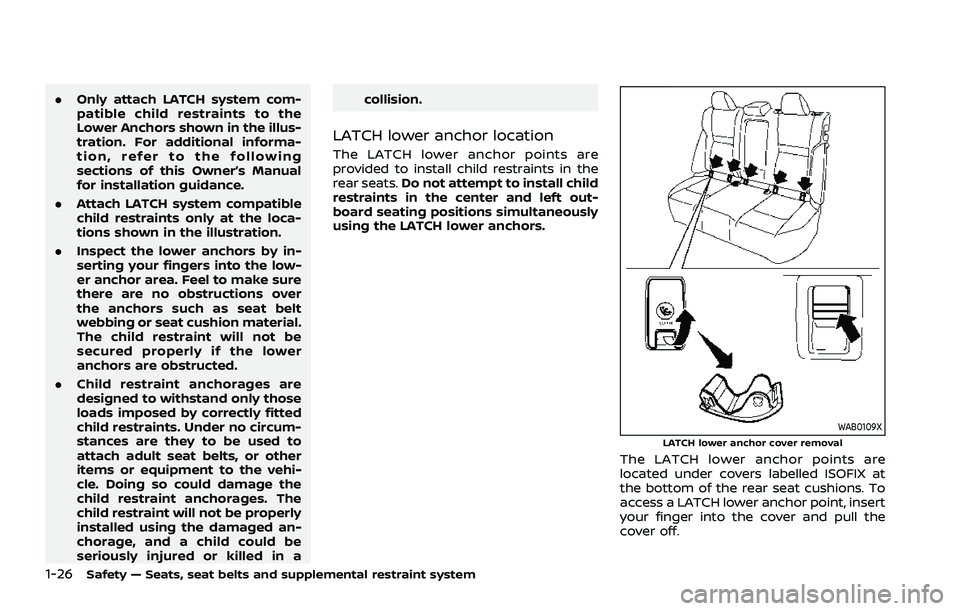
1-26Safety — Seats, seat belts and supplemental restraint system
.Only attach LATCH system com-
patible child restraints to the
Lower Anchors shown in the illus-
tration. For additional informa-
tion, refer to the following
sections of this Owner’s Manual
for installation guidance.
. Attach LATCH system compatible
child restraints only at the loca-
tions shown in the illustration.
. Inspect the lower anchors by in-
serting your fingers into the low-
er anchor area. Feel to make sure
there are no obstructions over
the anchors such as seat belt
webbing or seat cushion material.
The child restraint will not be
secured properly if the lower
anchors are obstructed.
. Child restraint anchorages are
designed to withstand only those
loads imposed by correctly fitted
child restraints. Under no circum-
stances are they to be used to
attach adult seat belts, or other
items or equipment to the vehi-
cle. Doing so could damage the
child restraint anchorages. The
child restraint will not be properly
installed using the damaged an-
chorage, and a child could be
seriously injured or killed in a collision.
LATCH lower anchor location
The LATCH lower anchor points are
provided to install child restraints in the
rear seats.
Do not attempt to install child
restraints in the center and left out-
board seating positions simultaneously
using the LATCH lower anchors.
WAB0109XLATCH lower anchor cover removal
The LATCH lower anchor points are
located under covers labelled ISOFIX at
the bottom of the rear seat cushions. To
access a LATCH lower anchor point, insert
your finger into the cover and pull the
cover off.
Page 47 of 556
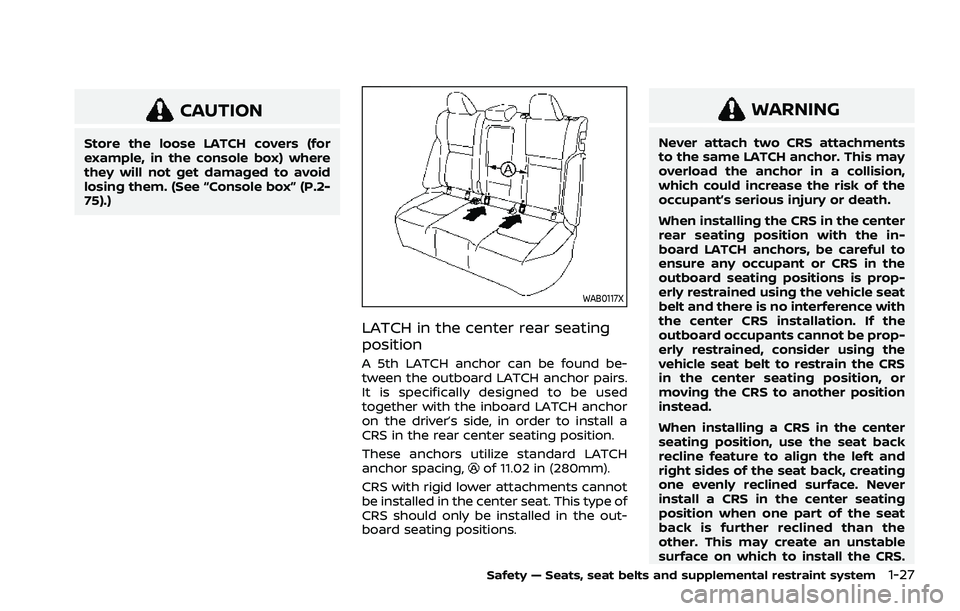
CAUTION
Store the loose LATCH covers (for
example, in the console box) where
they will not get damaged to avoid
losing them. (See “Console box” (P.2-
75).)
WAB0117X
LATCH in the center rear seating
position
A 5th LATCH anchor can be found be-
tween the outboard LATCH anchor pairs.
It is specifically designed to be used
together with the inboard LATCH anchor
on the driver’s side, in order to install a
CRS in the rear center seating position.
These anchors utilize standard LATCH
anchor spacing,
of 11.02 in (280mm).
CRS with rigid lower attachments cannot
be installed in the center seat. This type of
CRS should only be installed in the out-
board seating positions.
WARNING
Never attach two CRS attachments
to the same LATCH anchor. This may
overload the anchor in a collision,
which could increase the risk of the
occupant’s serious injury or death.
When installing the CRS in the center
rear seating position with the in-
board LATCH anchors, be careful to
ensure any occupant or CRS in the
outboard seating positions is prop-
erly restrained using the vehicle seat
belt and there is no interference with
the center CRS installation. If the
outboard occupants cannot be prop-
erly restrained, consider using the
vehicle seat belt to restrain the CRS
in the center seating position, or
moving the CRS to another position
instead.
When installing a CRS in the center
seating position, use the seat back
recline feature to align the left and
right sides of the seat back, creating
one evenly reclined surface. Never
install a CRS in the center seating
position when one part of the seat
back is further reclined than the
other. This may create an unstable
surface on which to install the CRS.
Safety — Seats, seat belts and supplemental restraint system1-27
Page 48 of 556
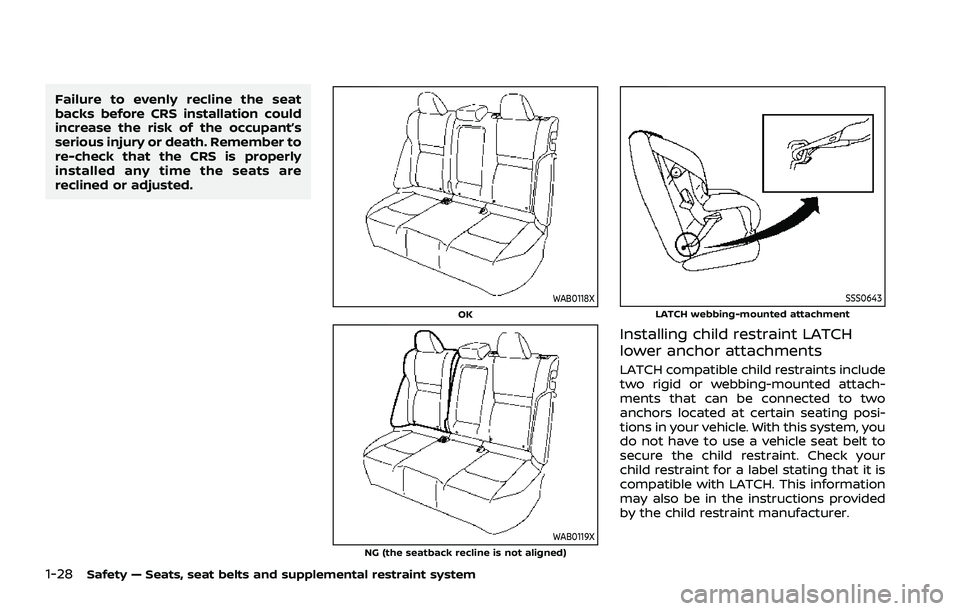
1-28Safety — Seats, seat belts and supplemental restraint system
Failure to evenly recline the seat
backs before CRS installation could
increase the risk of the occupant’s
serious injury or death. Remember to
re-check that the CRS is properly
installed any time the seats are
reclined or adjusted.
WAB0118XOK
WAB0119XNG (the seatback recline is not aligned)
SSS0643LATCH webbing-mounted attachment
Installing child restraint LATCH
lower anchor attachments
LATCH compatible child restraints include
two rigid or webbing-mounted attach-
ments that can be connected to two
anchors located at certain seating posi-
tions in your vehicle. With this system, you
do not have to use a vehicle seat belt to
secure the child restraint. Check your
child restraint for a label stating that it is
compatible with LATCH. This information
may also be in the instructions provided
by the child restraint manufacturer.
Page 49 of 556

SSS0644LATCH rigid-mounted attachment
When installing a child restraint, carefully
read and follow the instructions in this
manual and those supplied with the child
restraint.
Top tether anchor
WARNING
Properly secure cargo and do not
allow it to contact the top tether
strap when it is attached to the top
tether anchor. Cargo that is not
properly secured or cargo that con-
tacts the top tether strap may da-
mage the top tether strap during acollision. If the cargo cover (if so
equipped) contacts the top tether
strap when it is attached to the top
tether anchor, remove the cargo
cover from the vehicle. If the cargo
cover is not removed, it may damage
the top tether strap during a colli-
sion. Your child could be seriously
injured or killed in a collision if the
child restraint top tether strap is
damaged.
WAB0110X
Top tether anchor point locations
WARNING
Child restraint anchorages are de-
signed to withstand only those loads
imposed by correctly fitted child
restraints. Under no circumstances
are they to be used to attach adult
seat belts, or other items or equip-
ment to the vehicle. Doing so could
damage the child restraint an-
chorages. The child restraint will not
be properly installed using the da-
maged anchorage, and a child could
be seriously injured or killed in a
Safety — Seats, seat belts and supplemental restraint system1-29
Page 50 of 556
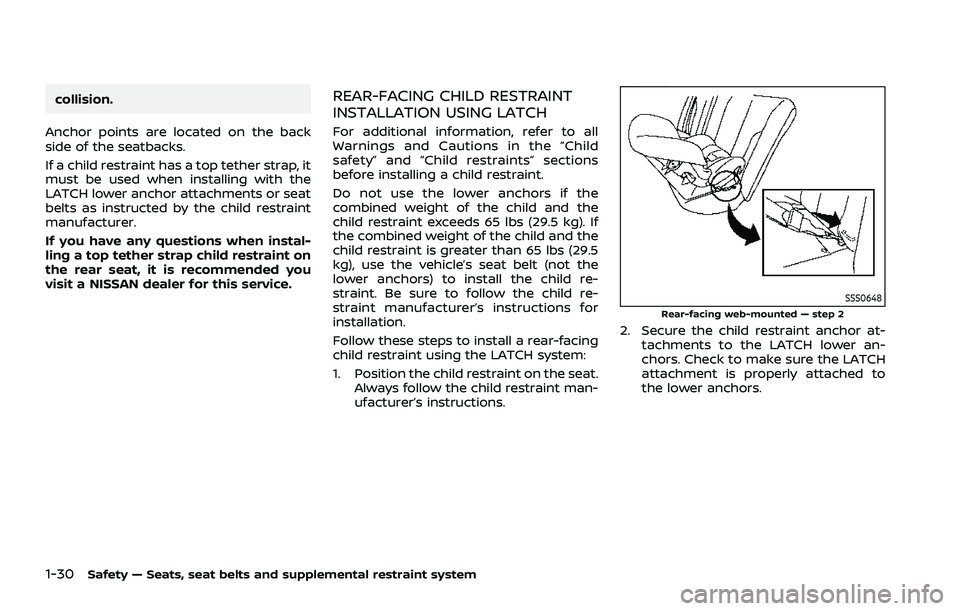
1-30Safety — Seats, seat belts and supplemental restraint system
collision.
Anchor points are located on the back
side of the seatbacks.
If a child restraint has a top tether strap, it
must be used when installing with the
LATCH lower anchor attachments or seat
belts as instructed by the child restraint
manufacturer.
If you have any questions when instal-
ling a top tether strap child restraint on
the rear seat, it is recommended you
visit a NISSAN dealer for this service.REAR-FACING CHILD RESTRAINT
INSTALLATION USING LATCH
For additional information, refer to all
Warnings and Cautions in the “Child
safety” and “Child restraints” sections
before installing a child restraint.
Do not use the lower anchors if the
combined weight of the child and the
child restraint exceeds 65 lbs (29.5 kg). If
the combined weight of the child and the
child restraint is greater than 65 lbs (29.5
kg), use the vehicle’s seat belt (not the
lower anchors) to install the child re-
straint. Be sure to follow the child re-
straint manufacturer’s instructions for
installation.
Follow these steps to install a rear-facing
child restraint using the LATCH system:
1. Position the child restraint on the seat. Always follow the child restraint man-
ufacturer’s instructions.
SSS0648Rear-facing web-mounted — step 2
2. Secure the child restraint anchor at-
tachments to the LATCH lower an-
chors. Check to make sure the LATCH
attachment is properly attached to
the lower anchors.